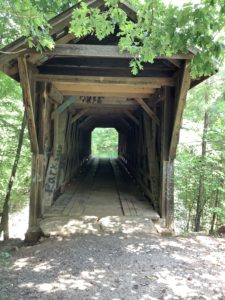Finding Excellent Craftsmanship

Where can you find excellence in craftsmanship?
Recently, my husband and I visited Hickory, NC to see the Bunker Hill bridge, one of the oldest covered bridges in the country. Since it was built in 1895, we expected to see a dilapidated, rickety old structure at the end of the trail. Not so!
You can imagine our surprise when we approached a bridge that would rival any structure built today. As we walked across the sturdy boards, we were amazed they were still solid after more than a century had passed. We didn’t feel a bit of shakiness or movement, even when we jumped up and down. What had made this bridge such a fortress?
Curious, we peered under the bridge to see how it was supported. The structure had no steel beams to hold the weight, only century old boards. Two gigantic wooden beams underneath the bridge supported the weight. Six huge boards, four inches thick, were bound together to form one massive beam on each side under the bridge.
These wooden beams must have been fashioned from old-growth wood. Lumber that enormous and that strong would not be available today. Also, old-growth wood is extremely hard, making it less desirable to termites and carpenter ants. That’s why insects have left it alone, even after all these years.
The wooden trusses that braced the sides of the bridge also surprised us. These joining trusses were not fastened with heavy bolts as we expected. Instead, wooden pegs held them together. Those pegs must have worked well since they have kept the bridge securely fastened for one hundred and twenty-seven years!
As we read the nearby plaques, we learned more about this amazing bridge. A man named Henry Haupt designed it in 1895. This engineer created a successful truss design which is still included in engineering books today. Mr. Haupt’s work has certainly stood the test of time. Modern civil engineers continue to use his design in their work today.
We also learned a few interesting facts about covered bridges. Many people believe these bridges were constructed so horses wouldn’t be afraid to cross a river or ravine. According to the plaque, the main reason why men constructed covered bridges was longevity. A regular bridge that was exposed to the weather would last only fifteen or twenty years. However, a covered bridge could last one hundred years.
As we looked at this impressive bridge, I was reminded off the fine craftsmanship I wrote about in my new Ella’s America series. In the 1800s, people like Ella could visit local workmen like a cooper, a blacksmith, a tinsmith, or a cobbler to watch them work.
Unlike businesses today that send products all over the world, nineteenth century workmen sold their products locally. They took great care in their work because their friends and neighbors would use their products. The men produced items of high quality which were made to last a long time. Today, many items are cheap, disposable products meant to be replaced in a short time.
In Ella’s day, excellent craftsmanship was valued because the worker’s reputation was important. For that reason, you should check out old pieces if you want to find good craftsmanship.


The Conversation
Great article, JoAnne. I wish I’d known about that bridge when Stewart and I drove to Hickory to pick up our dog, Winston.